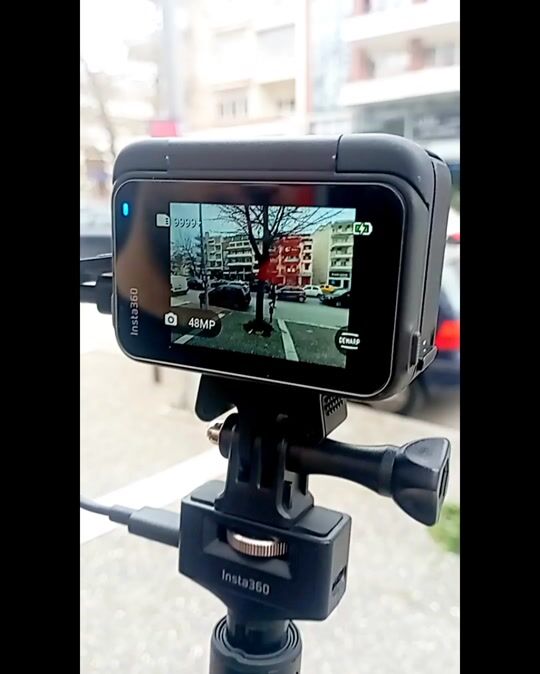Morning walking video in Metsovo with snow and the built-in Snow 1 filter active for snow and low-light video:
https://www.youtube.com/watch?v=e96MZ9wm4dE
Night driving video in Sparta with the PureVideo setting, which is ideal for low-light shots:
https://www.youtube.com/watch?v=YFT0T4eHSvo
The remarkable proposal from Insta360 shows that the company has significantly improved in the action camera space and is trying to offer the best from both "worlds" (GoPro Vs DJI). In fact, it seems to be doing quite well and is now a worthy choice, but also (almost) a one-way street for night videos. Moreover, it pioneers as the first action camera with a dual processor (one regular and one AI).
Let's take a closer look:
Build Quality/Dimensions/Weight/Waterproofing:
Sturdy construction, much sturdier than its predecessors, the modular Insta360 One R/RS, and I believe that, despite the bizarre idea of incorporating a foldable screen, it is as robust as its competitors GoPro and DJI.
Also, its dimensions are quite notable, as the camera has slightly greater thickness (front to back, from the screen to the lens) and height (from the base to the button on top) and the same width compared to the GoPro Hero 12, but it is considerably bulkier than the DJI Osmo Action 3/4.
It is also a bit heavier than the GoPro Hero 12 and significantly heavier than the DJI Osmo Action 3/4.
Insta360 claims it is waterproof up to 10 meters; personally, I tested it up to 1.5 meters with some fear because they say that some pieces have issues with the memory card cover, but I did not encounter any problems.
Screen Quality/Battery Life/Battery Charging/Overheating Resistance:
It features 2 screens: A simple small LCD screen on the front that exists merely to provide some information and the foldable touchscreen that has slightly mediocre image quality in terms of pixels, good brightness, and excellent responsiveness to commands even with wet fingers.
In PureVideo (the setting at 4K@25 for purely night videos), the battery lasts around 1 hour and 20 minutes before dropping to 5% and automatically stopping video recording, while the camera heats up quite a bit but does not shut down.
UPDATE: After the last update (September), the quality of night videos has improved even more, but the camera heats up even more, while the camera's autonomy has dropped by 10 minutes, so it is now at 1 hour and 10 minutes of continuous video recording. Also, now the camera consumes a very small percentage of battery (around 1% per day) even when it is off...
In regular video, also at 4K@25, it can record continuously for 1 hour and 40 minutes, with the camera remaining lukewarm to warm.
In FreeFrame (to adjust it later to 16:9 or 9:16), it records video for 1 hour and 29 minutes before dropping to 5% and automatically stopping video recording, and the camera is simply warm.
It has fast charging, and without timing it precisely, the battery seems to go from 5% to 100% in about 30 minutes.
Regarding overheating, in a comparative test between the DJI Osmo Action 4, GoPro Hero 12, and Insta360 Ace Pro with the following settings: 4K@50fps, Horizon Leveling at 45 degrees, the screen permanently active at 100% brightness, external temperatures between 28 and 32 degrees Celsius, and with the cameras exposed to the sun, the Ace Pro exceeded 22 minutes of continuous recording, leaving the GoPro Hero 12 and DJI Osmo Action 4 significantly behind, which barely managed to record videos of 13 minutes and 9 minutes respectively.
Video quality/Night videos/Video duration/Zoom/Horizon range and image distortion: The Insta360 claims that the camera can record video up to 8K@24fps. I haven't tested it, but those who have tried it and studied the pixels said that there isn't a significant difference compared to 4K, so it is more theoretical than actual 8K. It is important to note that if you shoot video at 25 frames per second, its particularly noteworthy HDR is activated automatically, and the results are quite impressive.
In night videos and low-light videos, the Insta360 excels since, thanks to the additional AI processor, it offers better stabilization, less noise, clearer images with more vibrant colors, and almost no flicker compared to the DJI Osmo Action 4 (the GoPro, despite improvements, continues to come in third and lagging in low-light videos), at the cost of reduced autonomy, as both processors of the camera operate to achieve this. The significant difference from the previous Insta 360 (One R/RS) lies in the fact that the AcePro is capable of recording continuous video. One R/RS users know very well that these cameras interrupted recording for a few seconds after 29 minutes of recording and then continued again, resulting in lost footage when the user wanted to record continuous video for many hours (like me in the driving videos I upload to the channel https://www.youtube.com/@TravellerChris). While in One R/RS the (3X if I remember correctly) zoom is digital, it is done manually, more smoothly (with a bit of practice), and the image pixelates quite a bit, in the Ace Pro the zoom is 2X, done automatically, abruptly, and due to AI technology, the loss of detail is negligible.
Regarding the horizon range, in the Horizon Leveling setting, it is at the levels of the GoPro, but as we increase to Dewarp, Action, and Ultra, it seems that the GoPro offers a larger horizon range (the DJI Osmo Action 4 offers the largest horizon range without the addition of any extra accessory), but the image distortion is significantly smaller in the Insta360 AcePro.
Photos/Other features: The 48MP photos it takes are particularly noteworthy, clear, and with beautiful colors, while it has HDR photography, Interval, Burst, and Slow Motion video, Loop Recording, Timelapse, and TimeShift features. In Starlapse, it simultaneously takes HDR photos and videos, offering much greater creative freedom, while it has much less noise and a brighter image compared to the corresponding feature of the GoPro Hero 12.
Mobile app/PC and Mac software: The mobile app is fast, reliable, has many video editing options, as well as short tutorials, while it also unlocks the ability to edit videos via AI, but up to 1080p. Also, it is necessary to activate the camera the first time. The connection is very good, stable, and allows live view of the content at any time. The app for PC and Mac is more basic, but it allows color editing, digital de-noise, modifications to the video (speed up/slow down and add motion blur).
Package contents: The package includes the camera (obviously), a plastic quick-release adapter with a strong magnet and 4 hooks, a single-use adhesive base (that is, it can stick once to a smooth surface, but will remain "permanently" in that spot), a USB-C to USB-C cable, two cards with stickers, and the printed manuals.
Negatives:
1) The fact that the lens protector is integrated (glued) onto the camera's chassis, so removing it means an automatic loss of warranty.
2) The MicroSD is located under the USB-C port cover and not next to the battery, as is common with DJI, which means that in case the camera is powered via cable, the MicroSD and, consequently, the entire camera are exposed to moisture and weather conditions. Of course, this may be one of the reasons the camera takes time to overheat, as the battery and MicroSD card generate the most heat inside the camera.
3) The obsession of the Chinese with magnets... Yes, the plastic quick-release adapters are quite strong, but I don't feel completely safe when I have the camera mounted outside the car and I'm driving at 80km/h or 90km/h, while the camera doesn't have any protrusion for tethering with a rope. The only real solution is the very expensive metal multi-adapter from Insta360 with the locking mechanism, which is hard to find in Greece and very expensive on the Insta360 site.
4) Its price, which is quite steep compared to the competition. Based on current prices, it is about €70 more expensive than the Standard versions of DJI and GoPro.
If you want more information (and videos) about the Insta360 AcePro, you can find them on my channel:
https://www.youtube.com/@TravellerChris























































